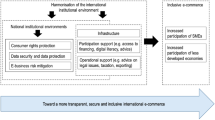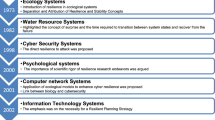Abstract
Networks have become an increasingly important mode of public governance. ICT mechanisms, especially virtual systems will potentially establish this idea. This paper is based on a comparative analysis of three cases which are chosen to be particularly illustrative of the three virtual governance networking policies. In light of case study results, we have demonstrated that it is possible to devise a theoretically acceptable prospect of world countries concerning virtual governance networking policies.





Similar content being viewed by others
Notes
In assessing what had been done throughout the world, we have been greatly helped by the web site developed by the European Union http://europa.eu.int/index_en.htm. This web site contains an extensive e-government news watch index that was of tremendous help in this research.
References
Adshead, M., & Quinn, B. 1998. The move from government to governance: Irish development policy’s paradigm shift. Policy & Politics, 26(2): 209–25. doi:10.1332/030557398782025682.
Argyle, M. 1991. Co-operation: The basis of sociability. London: Routledge.
Bellamy, C., & Taylor, J. A. 1998. Governing in the Information Age. Buckingham: Open University Press.
Boss, S., McGranahan, D., Asheet, M. 2000. Will the Banks Control Online Banking? The McKinsey Quarterly. http://www.mckinseyquarterly.com.
Bovaird, T. 2002. Public administration: emerging trends and potential future directions. In: Eran, V. (Ed.), Public administration: an interdisciplinary critical analysis, 345–376. New York: Marcel Dekker.
Bovaird, T., & Loffler, E. 2003. Public Management and Governance. London and New York: Routledge.
Brussard, B. K. 1988. Information Re-Source Management in the Public Sector. Information and Management, 15: 85–92.
Communication Capstone 2001. Issues in Communication Study. Theory Workbook. http://www.uky.edu/~drlane/capstone/mass.
Correia, Z. P. 2005. Towards a stakeholder model for the co-production of the public-sector information system. Information Research, 10 (3), paper 228, http://InformationR.net/ir/10-3/paper228.html.
Doornbos, M. 2003. Good governance: the metamorphosis of a policy metaphor. J Int. Aff, 57(1): 3–18. doi:10.1080/1035771032000073588.
Dowding, K. 1995. Model of metaphor? A critical review of the policy network approach. Polit Stud, 43(1): 136–158. doi:10.1111/j.1467-9248.1995.tb01705.x.
Farazmand, A. 2004. Sound Governance: Policy and Administrative Innovations. Westport, CT: Praeger.
Freeman, E. 1984. Strategic management: a stakeholder approach. London: Pitman.
Halachmi, A. 2005. Governance and risk management: challenges and public productivity. Int. J Public Sect Manag, 18(4): 300–317. doi:10.1108/09513550510599238.
Kickert, W. J. M., Klijn, E. H., & Koppenjan, J. F. M. 1997. Managing Complex Networks: Strategies for the Public Sector. London: Sage.
Klijn, E. H., & Teisman, G. R. 1997. Strategies and Games in Networks. In: Kickert, W. J. M., Klijn, E. H., & Koppenjan, J. F. M. (Eds.), Managing Complex Networks: Strategies for the Public Sector: 98–118. London: Sage.
Klijn, E. H., & Teisman, G. R. 2002. Partnership arrangements: governmental rhetoric or governance scheme? Public Administration Review, 62(2): 189–198.
Kooiman, J. 1993. Socio-Political Governance. In: Kooiman, J. (Ed.), Modern Governance: London: Sage.
Laswell, H. 1948. The structure and function of communication and society: The communication of ideas. 203–243. New York: Institute for Religious and Social Studies.
Marin, B., & Mayntz, R. 1991. Studying Policy Networks. In: Marin, B., & Mayntz, R. (Eds.), Policy Networks: Empirical Evidence and Theoretical Considerations: 11. Boudler, CO: Westview.
Narayanan, V. K., & Nath, R. 1993. Organization theory: a strategic approach. Boston, MA: Irwin.
Neu, C. 1996. Local governance: the next change frontier. Illinois Municipal Review. http://www.lib.niu.edu/ipo/im960313.html.
Newkirk, M. G. 2004. US Public Opinion toward Voting Technologies. InfoSENTRY Services. 2004.http://www.infosentry.com/US_Public_Opinion_Toward_Voting_Technology_20040301.pdf. 21.01.2007.
OECD 2001a. Engaging citizens in policy-making: information, consultation and public participation, PUMA Policy Briefing No.10.. Paris: OECD.
Pierre, J., & Peters, B. G. 2000. Governance, politics and the state. New York: St Martin’s Press.
Rhodes, R. 1996. The new governance: governing without government.. Political Studies, 44(3): 652–667. doi:10.1111/j.1467-9248.1996.tb01747.x.
Rhodes, R. 1997. Understanding Governance: Policy Networks, Governance, Reflexivity and Accountability. Open University Press.
Schwartz, E. d. 1996. Excerpt from NetActivism: How Citizens Use the Internet. http://oreilly.com/catalog/netactivism/excerpt/index.html.
Snellen, I. T. M. 1992. Information policies: A comparative Analysis. In: Frisson, P. H. A., Bekkers, V. J. J. A. M., Brussard, B. K., Snellen, I. T. M., & Wolters, M. (Eds.), European Public Administration and Informatization, 11–23. Amesterdam/Oxford/Washington/Tokyo: IOS.
Snellen, I. T. M., & Van de Donk, W. B. H. J. 1998 Public Administration in an Information Age (ed.), Amesterdam/Oxford/Washington/Tokyo: IOS Press
Wright, W. R. 1960. Functional analysis and mass communication. Public Opinion Quarterly, 24: 605–620. doi:10.1086/266976.
Acknowledgments
As authors, we would like to thank the anonymous reviewers for their review and comments on the several revised versions of our manuscript. We also especially thank the Editor in Chief, Professor Farazmand for his numerous constructive suggestions and supportive comments, English editing of the final version, as well as the extensive corrections he has made on the proof pages to clean up the article text.
Author information
Authors and Affiliations
Corresponding author
Rights and permissions
About this article
Cite this article
Didehvar, F., Danaeefard, H. Virtual Governance Networking Policies: A Comparative Analysis. Public Organ Rev 10, 1–16 (2010). https://doi.org/10.1007/s11115-009-0079-6
Published:
Issue Date:
DOI: https://doi.org/10.1007/s11115-009-0079-6




